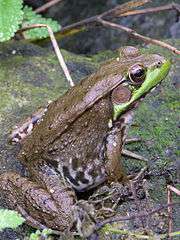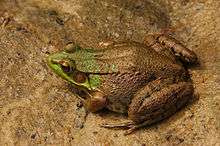Rana clamitans
| Green frog | |
|---|---|
 | |
| Male, Tewksbury Township, New Jersey | |
| Scientific classification | |
| Kingdom: | Animalia |
| Phylum: | Chordata |
| Subphylum: | Vertebrata |
| Class: | Amphibia |
| Order: | Anura |
| Family: | Ranidae |
| Genus: | Rana |
| Species: | R. clamitans |
| Binomial name | |
| Rana clamitans Latreille, 1801 | |
| Subspecies | |
|
See text | |
 | |
| Green frog range | |
| Synonyms | |
The green frog (Rana clamitans[4]) is a species of frog native to the eastern half of the United States and Canada. The two subspecies are the bronze frog and the northern green frog.
Description
This species is a mid-sized true frog. Adult green frogs range from 5–10 cm (2.0–3.9 in) in body length (snout to vent, excluding the hind legs). The typical body weight of this species is from 28 to 85 g (0.99 to 3.00 oz).[5][6] The sexes are sexually dimorphic in a few ways: mature females are typically larger than males, the male tympanum is twice the diameter of the eye, whereas in females, the tympanum diameter is about the same as that of the eye, and males have bright yellow throats. The dorsolateral ridges, prominent, seam-like skin folds that run down the sides of the back, distinguish the green frog from the bullfrog, which entirely lacks them.
Habitat
Green frogs live wherever shallow freshwater ponds, road-side ditches, lakes, swamps, streams, and brooks are found. Most often seen resting along the shore, they leap into the water when approached. By inhabiting an ecotone, in this case the terrestrial and aquatic habitat boundary, green frogs (and other aquatic ranid frogs), by employing a simple leap, leave behind their many and faster terrestrial enemies that cannot similarly cross that boundary.
Behavior
Adult green frogs are highly aquatic, but juveniles will sometimes go overland when the grass and soil are wet. This species is usually diurnal, although their calls are sometimes heard at night during hotter weather.
Reproduction

Green frogs breed in semipermanent or permanent fresh water. Males call from and defend territories. The distinctive call sounds like a plucked banjo string, usually given as a single note, but sometimes repeated.
The breeding season is from April to August.
Actual mating involves amplexus, whereby the male grasps the female with his forelimbs posterior to her forelimbs. The female releases her eggs and the male simultaneously releases sperm which swim to the egg mass. Fertilization takes place in the water. A single egg clutch may consist of 1000 to 7000 eggs, which may be attached to submerged vegetation.
Green frog tadpoles are olive green and iridescent creamy-white below. Metamorphosis can occur within the same breeding season or tadpoles may overwinter to metamorphose the next summer. Males become sexually mature at one year, females may mature in either two or three years.
Feeding
Green frogs will attempt to eat any mouth-sized animal they can capture, including insects, spiders, fish, crayfish, shrimp, other frogs, tadpoles, small snakes, birds, and snails. Tadpoles graze on algae and water plants.
Conservation status
The green frog is one of the most abundant frogs wherever it occurs and has no known problems. Green frogs are protected by the law in some US states.
Subspecies
The two recognized subspecies of R. clamitans are:
- Rana clamitans clamitans Latreille, 1801 – bronze frog
- Rana clamitans melanota (Rafinesque, 1820) – northern green frog
Gallery
-

Hand held
-

Female, from the side
-
Female, from the back, showing dorsolateral ridges
-

Female
-
Green frog covered in mosquitos
-

Female, facing left
-

Green frog taken in Mohegan Lake, NY.
-

Green frog
-

Blue morph, Fletcher Wildlife Garden, Ottawa, Ontario
External links
- ARMI: Green Frog Includes links to sound files of Green Frog calls.
- Green Frog, Rana clamitans melanota, CARCNET
- Gardens, Green Gardens, Maintenance
Footnotes
- ↑ Hillis 2007.
- ↑ Hillis and Wilcox 2005.
- ↑ Pauly, Greg B.; Hillis, David M.; & Cannatella, David C. (2009). "Taxonomic freedom and the role of official lists of species names". Herpetologica 65 (2): 115–128. doi:10.1655/08-031R1.1.
- ↑ "Lithobates clamitans". Integrated Taxonomic Information System. Retrieved 31 January 2012.
- ↑ Green Frog (true frog family). epa.gov
- ↑ GREEN FROG. Rana clamitans melanota. uri.edu
References
| Wikimedia Commons has media related to Rana clamitans. |
| Wikispecies has information related to: Rana clamitans |
- Hammerson, G. (2004). Rana clamitans. 2006. IUCN Red List of Threatened Species. IUCN 2006. www.iucnredlist.org. Retrieved on 12 May 2006. Database entry includes a range map and justification for why this species is of least concern.
- Hillis, D.M., & Wilcox, T.P. (2005). Phylogeny of the New World true frogs (Rana). Mol. Phylogenet. Evol. 34 (2): 299–314. doi:10.1016/j.ympev.2004.10.007 PDF fulltext. Erratum in Mol. Phylogenet. Evol. 41 (3): 735. doi:10.1016/j.ympev.2004.10.024
- Hillis, D.M. (2007). Constraints in naming parts of the Tree of Life. Mol. Phylogenet. Evol. 42 (2): 331–338.
- Latreille, P.A. 1801. In: Sonnini, C.S., & Latreille, P.A. (1801). Histoire naturelle des reptiles, avec figures desinées d'après nature; Tome II. Première partie. Quadrupèdes et bipèdes ovipares [= Natural History of the Reptiles, with Figures Drawn from Nature; Volume 2. First Part. Oviparous Quadrupeds and Bipeds]. Paris: Deterville. 332 pp. (Rana clamitans, new species, pp. 157-158). (in French).


